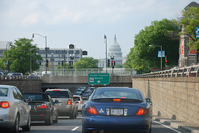Lang/Trachtenberg economic development transition pushes archaic transportation approach

Photo by Joe Shlabotnik on Flickr.
I’m working on analyzing the transportation claims in Mayor Gray’s transportation transition document. Meanwhile, the economic development document contains some terrible transportation policy recommendations that need no further research.
That transition team, headed by Chamber of Commerce head Barbara Lang and former GW president Stephen Joel Trachtenberg, recommends that DC focus its transportation policy on making it easier for people to drive in and out of the District in order to bring in more jobs.
The transportation section, starting at the bottom of page 6, suggests retiming signals primarily around moving cars in and out, adding reversible lanes, and paying for traffic officers to direct traffic on major routes to Maryland and Virginia. These all represent the wrong approach. Basically, this is a traffic plan that comes from people who don’t know much about transportation.
The following words appear nowhere in the document: Metro, bus, transit, bicycle, walk, carpool. There is one sensible recommendation, to better enforce no parking and double parking rules.
Roads in and out and downtown are already very busy, despite a century of public policy around moving vehicles in and out. Parking is scarce and expensive. To grow, DC doesn’t need to move more vehicles. It needs to find ways to transport more people without adding more vehicles.
Bus and HOV lanes, for example, would let the same number of vehicles carry more people and provide faster ways in and out of DC for transit riders and sluggers. It would also do so without making dangerous roads, like Connecticut Avenue, even more dangerous for pedestrians.
It’s also odd that this transition team thinks that the best way to bring jobs to DC is to move more suburban residents in and out in single passenger vehicles. Maryland and Virginia residents don’t pay taxes to DC, and most of the jobs in the District now are government or nonprofit jobs that don’t pay taxes either. Why should DC prioritize continuing this status quo?
DC needs more jobs in technology and other intellectual, “creative class” sectors which will attract people who want to live near their jobs. It also needs more jobs which can employ those who live in DC today but haven’t been able to find jobs. This plan helps with neither.
This isn’t such a surprise from Barbara Lang. She testified at a Council hearing in 2008 that it’s not safe for her female employees to take Metro because they occasionally work until 10 or 11 at night. She also didn’t know if she provides any SmartBenefits to employees.
It’s too bad the DC Chamber of Commerce is instead acting like the Maryland and Virginia Chamber of Commerce. DC needs a business community that believes in the city and in growing the city’s strengths, including its relatively low car dependence. The Chamber of Commerce needs a leader who recognizes that, and in the meantime, Gray should put little stock in Lang’s ideas fresh from the 1950s.
